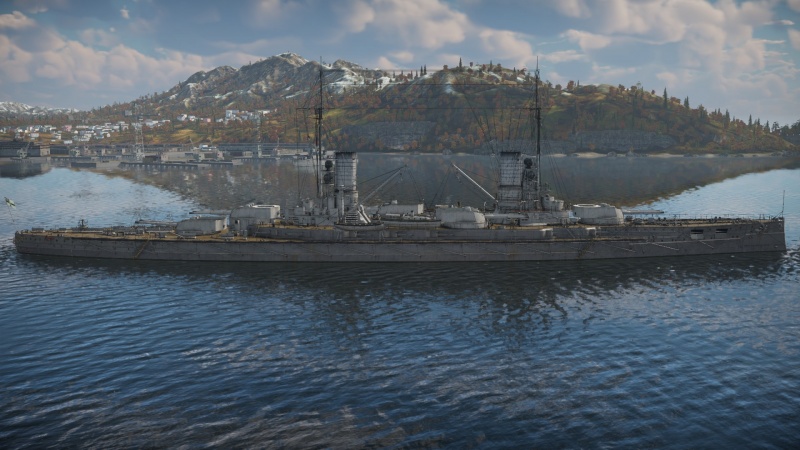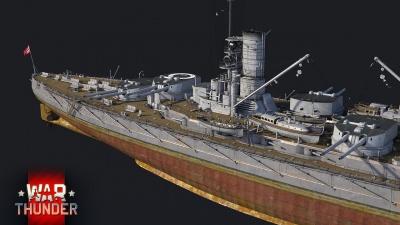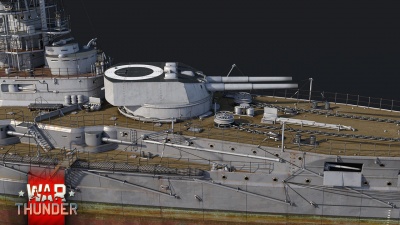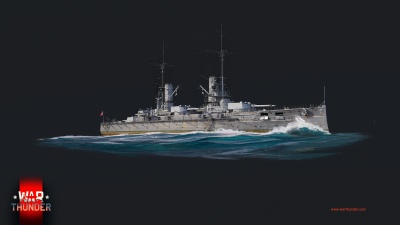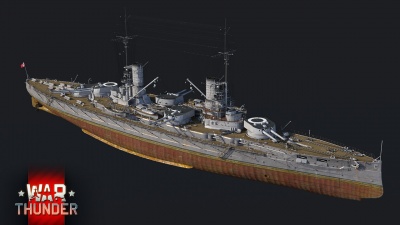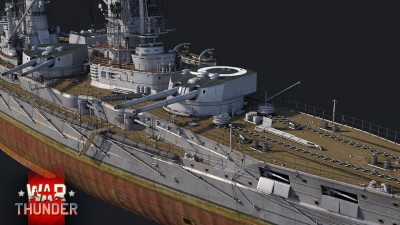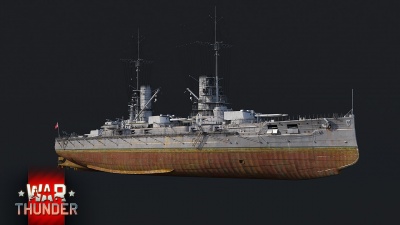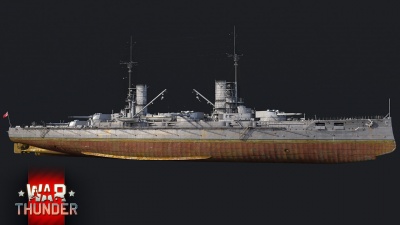SMS Kaiser
Contents
Description
The Kaiser-class, SMS Kaiser, 1911 is a rank German battleship with a battle rating of (AB), (RB), and (SB). It was introduced in Update "Ixwa Strike".
General info
Survivability and armour
Talk about the vehicle's armour. Note the most well-defended and most vulnerable zones, e.g. the ammo magazine. Evaluate the composition of components and assemblies responsible for movement and manoeuvrability. Evaluate the survivability of the primary and secondary armaments separately. Don't forget to mention the size of the crew, which plays an important role in fleet mechanics. Save tips on preserving survivability for the "Usage in battles" section. If necessary, use a graphical template to show the most well-protected or most vulnerable points in the armour.
Mobility
Write about the ship's mobility. Evaluate its power and manoeuvrability, rudder rerouting speed, stopping speed at full tilt, with its maximum forward and reverse speed.
| Mobility Characteristics | |||
|---|---|---|---|
| Game Mode | Upgrade Status | Maximum Speed (km/h) | |
| Forward | Reverse | ||
| AB | |||
| Upgraded | |||
| RB/SB | |||
| Upgraded | |||
Modifications and economy
Armament
Primary armament
Provide information about the characteristics of the primary armament. Evaluate their efficacy in battle based on their reload speed, ballistics and the capacity of their shells. Add a link to the main article about the weapon: {{main|Weapon name (calibre)}}. Broadly describe the ammunition available for the primary armament, and provide recommendations on how to use it and which ammunition to choose.
Secondary armament
Some ships are fitted with weapons of various calibres. Secondary armaments are defined as weapons chosen with the control Select secondary weapon. Evaluate the secondary armaments and give advice on how to use them. Describe the ammunition available for the secondary armament. Provide recommendations on how to use them and which ammunition to choose. Remember that any anti-air armament, even heavy calibre weapons, belong in the next section. If there is no secondary armament, remove this section.
Anti-aircraft armament
An important part of the ship's armament responsible for air defence. Anti-aircraft armament is defined by the weapon chosen with the control Select anti-aircraft weapons. Talk about the ship's anti-air cannons and machine guns, the number of guns and their positions, their effective range, and about their overall effectiveness – including against surface targets. If there are no anti-aircraft armaments, remove this section.
Additional armament
Describe the available additional armaments of the ship: depth charges, mines, torpedoes. Talk about their positions, available ammunition and launch features such as dead zones of torpedoes. If there is no additional armament, remove this section.
Usage in battles
Describe the technique of using this ship, the characteristics of her use in a team and tips on strategy. Abstain from writing an entire guide – don't try to provide a single point of view, but give the reader food for thought. Talk about the most dangerous opponents for this vehicle and provide recommendations on fighting them. If necessary, note the specifics of playing with this vehicle in various modes (AB, RB, SB).
Pros and cons
Summarise and briefly evaluate the vehicle in terms of its characteristics and combat effectiveness. Mark its pros and cons in the bulleted list. Try not to use more than 6 points for each of the characteristics. Avoid using categorical definitions such as "bad", "good" and the like - use substitutions with softer forms such as "inadequate" and "effective".
Pros:
Cons:
History
Devblog
During the 1900’s, the German Imperial navy placed orders for five new dreadnought battleships to be constructed in order to replace older warships of the Siegfried and Odin classes. These five new ships would become the Kaiser-class battleships, which among other technological advancements, featured turbine propulsion systems - a novelty on German warships at the time.
Kaiser, the lead ship of the class, was laid down in Kiel in December 1909, launched in March 1911 and subsequently commissioned in August 1912. After crew training and taking part in several fleet exercises, Kaiser along with its sistership König Albert and cruiser Strassburg, was sent on a long-distance cruise to German South-West Africa and South America to test the novel steam propulsion system for endurance and reliability. The flotilla returned from their cruise to Kiel in June of 1914.
Following the outbreak of the Great War, Kaiser took part in nearly every major naval operation of the conflict. This included the famous Battle of Jutland in mid 1916, where Kaiser sustained two direct hits, but suffered no substantial damage. Furthermore, Kaiser also took part in Operation Albion in 1917, bombarding Russian coastal positions in the Baltic, and crippling the destroyer Grom, followed by her sinking.
With the German surrender in November 1918, part of the High Seas Fleet, including the SMS Kaiser, was interned at the British naval base at Scapa Flow. The commanding German officer, Rear Admiral Ludwig von Reuter, believing that the fleet would be seized by the British, ordered the scuttling of the entire fleet on 21st of June, 1919. Kaiser was later raised in 1929 and broken up for scrap in the early 1930’s.
Media
See also
Links to articles on the War Thunder Wiki that you think will be useful for the reader, for example:
- reference to the series of the ship;
- links to approximate analogues of other nations and research trees.
External links
Paste links to sources and external resources, such as:
- topic on the official game forum;
- other literature.
| Germany battleships | |
|---|---|
| Nassau-class | SMS Nassau · SMS Westfalen |
| Helgoland-class | SMS Helgoland · SMS Ostfriesland |
| Kaiser-class | SMS Kaiser |
| Bayern-class | SMS Bayern · SMS Baden · SMS Sachsen |



